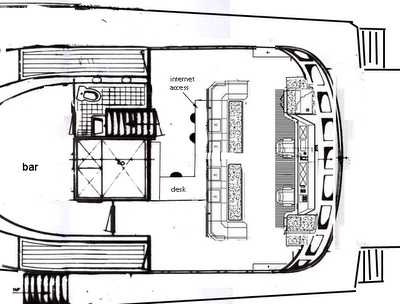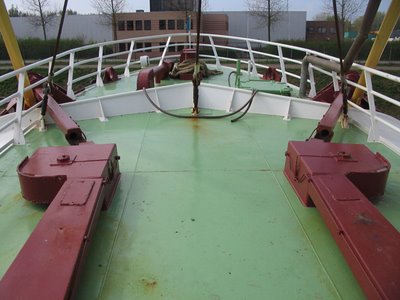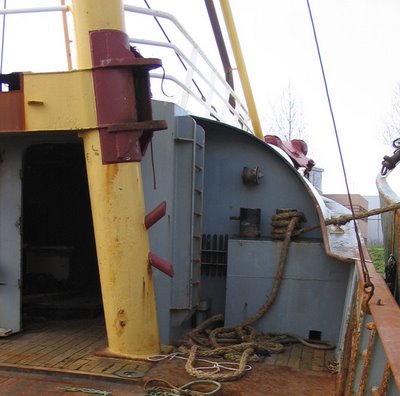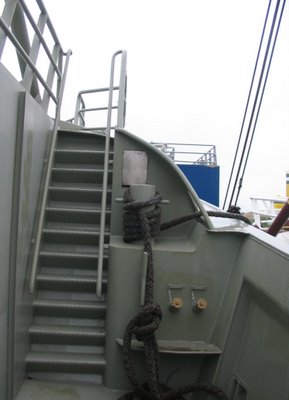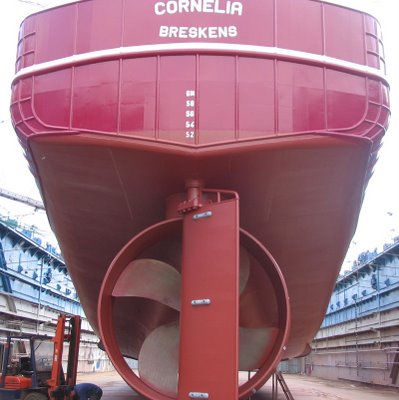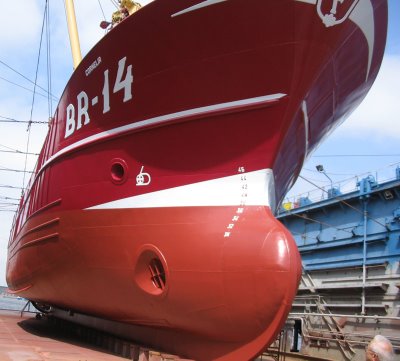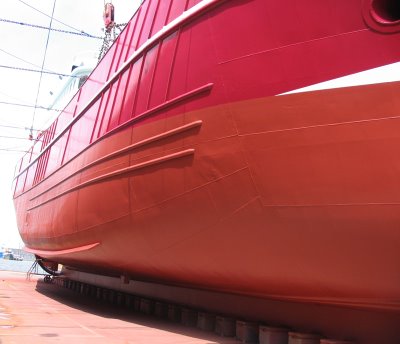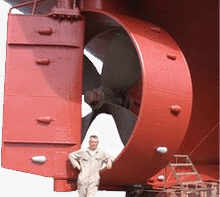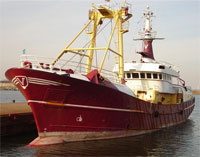
Friday, December 22, 2006
Happy Holidays

Thursday, December 21, 2006
Entertainment systems - an update

Thursday, December 7, 2006
Sanitary system
 Toilets on board of ships have some special requirements. Depending on the state of the sea, the discharge will be, let's say "the wrong way" unless special equipment is used. The modern solution is a vacuum system just like they use on airliners.
Toilets on board of ships have some special requirements. Depending on the state of the sea, the discharge will be, let's say "the wrong way" unless special equipment is used. The modern solution is a vacuum system just like they use on airliners.Wednesday, December 6, 2006
An expedition vessel without a sub?
 Right. Impossible! So, we plan to make this vessel sub ready in order to accommodate it once we can afford one. We already have a model in mind. The 3-person Triumph from SeaMagine.
Right. Impossible! So, we plan to make this vessel sub ready in order to accommodate it once we can afford one. We already have a model in mind. The 3-person Triumph from SeaMagine.This is without doubt the ultimate toy to have. But it's actually not a toy! It's a fully ABS classed submarine, capable to go down to 457 m (1500 ft). Yep. Serious stuff. With a serious price tag too.
 The photo below shows the sub placed on a platform at the stern but we would place it on the main deck in front so we don't increase the length of our vessel with would affect us in our Panama Canal transits.
The photo below shows the sub placed on a platform at the stern but we would place it on the main deck in front so we don't increase the length of our vessel with would affect us in our Panama Canal transits.
We'll be ready for it but for the time being, this $ub will have to wait. 
Need an appraisal for you vessel?

Some time ago I realized I might need some extra $$ to do the conversion. Talking with my local bank they asked me for a appraisal of the vessel. I looked at different companies and through the recommendation of Marijke Bot I found Van Duyvendijk & Zonen . They did a speedy job and came up with a fair value and a good report that helped me arrange more financing.
Monday, December 4, 2006
Building to class?
 Peter Watson of Watson Trawlers in Whangarei, has a design philosophy I totally share. His company makes a very fine line of steel trawlers and he wrote a very clear article on the matter of classification. To learn more about truly oceangoing trawlers yachts, visit his website www.realtrawlers.com
Peter Watson of Watson Trawlers in Whangarei, has a design philosophy I totally share. His company makes a very fine line of steel trawlers and he wrote a very clear article on the matter of classification. To learn more about truly oceangoing trawlers yachts, visit his website www.realtrawlers.comby Peter Watson
The classification societies are curious institutions. They are non-profit non-governmental incorporated societies who publish rules, standards, guides and other criteria for the design and construction of marine vessels of all kinds. They review designs and carry out surveys during construction to verify compliance with such rules. They issue certificates of survey on completion if the vessel has been built in accordance with their Rules and Regulations. Governments also grant them powers to issue Loadline, Tonnage and Safety Certificates for Merchant Shipping of all kinds operating in their Registry.
The principal Classification Societies that issue rules for Motor Yachts are:
- ABS – American Bureau of Shipping
- L.R. – Lloyds Register of Shipping
- BV – Bureau Veritas
 Each of these societies publishes Motor Yacht Rules for construction in steel, aluminum, GRP and wood. These Rules and Regulations have been developed over more than 100 years of trial and error, research and statistical analysis. They provide a good guide to designers and builders for design and construction even though it may not be intended to be “class” the vessel. It is from these Rules that we shall base our comments on Subdivision and Watertightness. Structural Strength, Machinery and Electrical Installation, Steering Gear and Equipment Installation.
Each of these societies publishes Motor Yacht Rules for construction in steel, aluminum, GRP and wood. These Rules and Regulations have been developed over more than 100 years of trial and error, research and statistical analysis. They provide a good guide to designers and builders for design and construction even though it may not be intended to be “class” the vessel. It is from these Rules that we shall base our comments on Subdivision and Watertightness. Structural Strength, Machinery and Electrical Installation, Steering Gear and Equipment Installation.
The decision to build to class should be made at the design stage because, from our experience, obtaining a class certificate after construction (CAC) is a very difficult proposition and at best the certificate will be a slightly inferior class.
What are the advantages of classification?
For the owner classification has great benefits.
- He can be certain that the vessel has been built to a recognized standard by properly certified personel after plan approval.
- The hull materials will be of an approved and certified type.
- The Classification certificate will be recognized by insurance companies and will result in lower premiums.
- The resale value of the vessel will be enhanced.
What are the disadvantages of classification?
- The build cost is higher.
- Annual fees are payable.
- The vessel is required to have annual surveys.
- The vessel has to be dry-docked every 2 1/2 years for a full underwater survey.
What class notations are available? The Classification Societies are reluctant to grant full Class notations to private motor yachts under about 78ft mainly because it is not economic for them to do so. They will however undertake plan approvals, survey the vessel during construction and issue a letter of attestation on completion stating that the vessel has been built according to their Rules and Regulations. There are no further surveys or fees payable after this time. If subsequent to this the owner converts the vessel to “ply for hire” or for other commercial purposes a classification certificate can be applied for based on the original letter of attestation. . It should also be borne in mind that if owners have future intentions of chartering their vessels many Government regulations are also applicable which are outside of the scope of degree of class mentioned. All these need to be considered at the design stage.
The Classification Societies are reluctant to grant full Class notations to private motor yachts under about 78ft mainly because it is not economic for them to do so. They will however undertake plan approvals, survey the vessel during construction and issue a letter of attestation on completion stating that the vessel has been built according to their Rules and Regulations. There are no further surveys or fees payable after this time. If subsequent to this the owner converts the vessel to “ply for hire” or for other commercial purposes a classification certificate can be applied for based on the original letter of attestation. . It should also be borne in mind that if owners have future intentions of chartering their vessels many Government regulations are also applicable which are outside of the scope of degree of class mentioned. All these need to be considered at the design stage.
For vessels over 78ft we recommend that a full Classification Certificate be obtained. For example our W79 Trawler Yacht is delivered with the following class notation:
Bureau Veritas - I 3/3E YACHT-/s ·MACH STB
- I 3/3E: indicates the hull is designed and built to the highest BV standards applicable.
- E: means the equipment (anchors and cable) meets the applicable requirements of the rules.
- YACHT-/s: indicates the service notation and hull material (steel).
- MACH: means the vessel machinery has type approval and is installed to BV satisfaction.
- STB: an inclining experiment has been carried out on the completed vessel and stability file prepared and approved.
In addition to the above it is well worth considering for vessels over 78ft, obtaining M.C.A certification. This certificate will allow the vessel to be chartered from Red Ensign States and thereby greatly enhance eventual saleabililty.
In conclusion it can be seen that some degree of class approval is beneficial for an owner of a trawler yacht and should be seriously considered. Beware of vessels advertised as “built to Lloyds Rules” or similar statement as this is a misleading and meaningless term. Few vessels built without plan approval and inspection during construction would be able to pass the rigorous classification process.
Sunday, December 3, 2006
Picture - anchor winch

Every two weeks I'll publish a picture with related comment on the subject.
I'll start with the anchor on this vessel. North Sea fishermen hardly ever anchored so ours needs some cleaning up.
We may add a 2nd anchor in the stern. Especially if we are going to cruise in tight spaces like the San Blas Islands or at anchor at the Balboa Yacht Club, at the entrance of the Panama Canal, this will give us total control about the area we need for safe anchoring.
Recommended websites
This page has a catagorized list of links to informative websites of vendors related to the effort of converting our trawler to an expedition yacht. You won't believe the stuff that's out there!
Expedition yachts
Electronics/power management/generator sets
Panel/wall systems & doors
- Isolamin floating floors and wall systems
Ceiling systems
- Dampa - Denmark
Many more to come.
Investors
 How do we finance this conversion to a go-anywhere expedition trawler yacht with space to comfortably care up to 20 guests + crew?
How do we finance this conversion to a go-anywhere expedition trawler yacht with space to comfortably care up to 20 guests + crew?We are still able to accommodate additional investors to finance the conversion and operation of this vessel. The estimated value after the completed conversion is $ 3 million. Fifty five percent of shared have already been placed and up to three 15%-share plans (or six 7.5% plans) remain available.
For more information, write thorwald@ilisa.com
Friday, December 1, 2006
Auxiliary systems
- water makers (SeaRecovery)
- central vacuum cleaning systems (Beamvac)
- sanitary systems. (Jets)
- air conditioning (see below)
- security/fire detection
- power & battery management (Victron Energy, Asea Power, and more)
- communication/Internet

First draft of plans by designer

Just got this in from the designer at Herman Jansen in The Netherlands who's turning my sketches into a real drawing. I can't wait to see more.
It shows a front mast we're going to change. Not sure yet what the future one will look like but definitely something smaller. Not that it looks bad, just expensive :-).
The bridge
Thursday, November 30, 2006
Why a (steel) trawler?

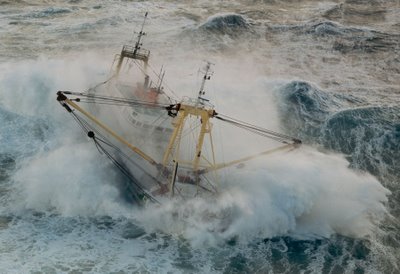 Several reasons. As John deCaro states on his very informative website BuyExploreryachts.com:
Several reasons. As John deCaro states on his very informative website BuyExploreryachts.com: 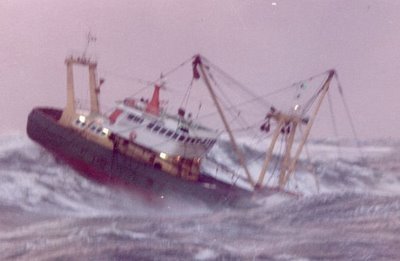
"Why is this important, what is the difference from a semi displacement vessel and is one better then the other? Both types of vessels are equally GOOD for their intended use. If you intend to travel only in protected and semi protected waters “coastwise” and want to go faster then what the water line length will allow, semi displacement is for you. If, however you want a long-range offshore vessel designed to handle demanding conditions then full displacement is the only choice. "
Getting to the front deck
Exhaust stag
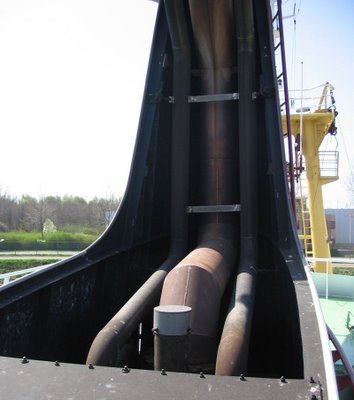
The hull
Fuel system

 Right now, we can carry 126 tons -just over 33 thousand gallons - of diesel oil.
Right now, we can carry 126 tons -just over 33 thousand gallons - of diesel oil.That's a little more than we anticipate we'll need even for really extended passage making. We'd probably run out of beer before we run out of fuel! With the anticpated economy cruising speed, we'd have a range of over ten thousand nautical miles. Even if we take eliminate the stern fuel tanks and keep our 4 bottom tanks (total capacity 90 tons), we could cruise non-stop from Rotterdam to Tahiti at 9 knots, making a side stop at Easter Island!. Check the route on Google Earth :-).
Fuel is currently cleaned with an Alfa Laval purifier.
Wednesday, November 29, 2006
My advisors

Right now, Willem Kramer, at Herman Jansen BV, the original design bureau of this and many other beautiful and very seaworthy trawlers are helping me put my ideas on paper or better, AutoCAD or similar.
I've also had a lot of help from Leun van Koppen of Maaskant shipyards, the ship's builder. This gentleman knows the ship inside out. I've thrown so many questions at him, he's still digesting them. And, I'm eternally greatful to him helping me find this ship (my wife clearly has a different opinion :-) ) and closing the deal.
On the engine front I've received a lot of help and 'education' from Richard Cuperus at Wartsila/Deutz, the engine manufacturer. He help me refresh what I had learned once about prop demand. They will take back the current 9 cyl. engine and get me a smaller 6 cylinder version.
I've also spend a great day and will surely be more in touch with Wim van Rij of Freetechnics. They make great stuff to keep an eye on anything on board. Check them out!
 Jan Klumpenaar at Victron Energy, makers of the very versatle MultiPlus system, thanks for answering my many e-mails and helping me find my way to Asea Power frequency converters, helping me save lots of $$ so I can still built a power system that we want.
Jan Klumpenaar at Victron Energy, makers of the very versatle MultiPlus system, thanks for answering my many e-mails and helping me find my way to Asea Power frequency converters, helping me save lots of $$ so I can still built a power system that we want.Lars Bo Anderson from CJC filters in Denmark, thanks for answering my many questions, sending me lots of info and setting up a great, very informative website; an example for other manufacturers.
I also want to mention Eric Vonk and Karin Schippers, proud owners of another, 44 m. Maaskant trawler. They living near Tampa, Florida and are traveling up and down to see the progress on their Scintilla Maris. They should start a blog too!
Crew cuarters

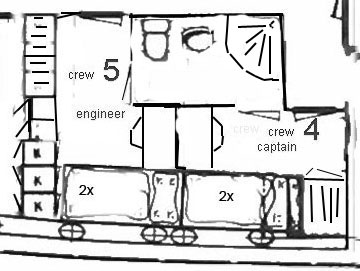 In the rear of the vessel, we'll create a small stateroom for the captain and engineer. They will share a bathroom. This way, they'll be very close to both bridge and engineroom. Of course, they will be able to monitor their relevant systems from their stateroom.
In the rear of the vessel, we'll create a small stateroom for the captain and engineer. They will share a bathroom. This way, they'll be very close to both bridge and engineroom. Of course, they will be able to monitor their relevant systems from their stateroom.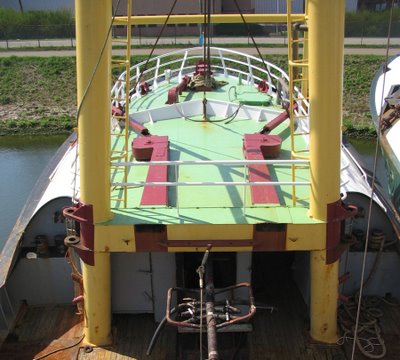
Storage below staterooms

Guest Cabins

 Below these staterooms there's still standing room (well, almost) and space for supplies and equipment like laundry and maybe some spare berths for crew. Or kids. Access will be from the main deck through the area indicated as 'naar onderruim'.
Below these staterooms there's still standing room (well, almost) and space for supplies and equipment like laundry and maybe some spare berths for crew. Or kids. Access will be from the main deck through the area indicated as 'naar onderruim'.All walls, doors and floors will meet SOLAS convention passengership standards and regulations related to fire safety and noise cancelling.
Tuesday, November 28, 2006
Diving equipment - from Bauer

We plan to install two portable Bauer Mariner compressors, a nitrox blending station and a few tanks for storage. We're still working on the details and trying to figure out the best location in the engine room.
To learn more about Bauer, check out there their (European) products at Bauer Kompressoren .
The American site is at Bauer Compressors.
 Our Bauer rep. in The Netherlands is CST Schiphorst. Harry Schiphorst gave us some really good advice on equipment selection and setup saving us big $$. So, the business is his.
Our Bauer rep. in The Netherlands is CST Schiphorst. Harry Schiphorst gave us some really good advice on equipment selection and setup saving us big $$. So, the business is his.Entertainment systems
We're looking into systems of AMX, Crestron, and Visiomatic (German). And also just learned about video servers of Kaleidescape and an audio solution from Sonos. That's all I can say at this point really. Still trying to figure out and how all those systems work together and what I need, but learning fast.
It's obvious that with enough $$ you can do anything but the idea is to find a reasonable balance between comfort, convenience and cost.
Saturday, November 25, 2006
Dining & living area
 The winch room, shown on the right (and below from the outside) is located below the bridge. We will remove the winches (anybody needs 20 tons of scrap??) will be extended forward.
The winch room, shown on the right (and below from the outside) is located below the bridge. We will remove the winches (anybody needs 20 tons of scrap??) will be extended forward.In here, we will create a dining area and living + bar. Of course, we can also have breakfast on the aft deck which will be partially covered. And what about the roof of the bridge? We'll add some cover there too. And possibly a jacuzzi....
Bridge deck
 The bridge deck will be modified to include a walk-around the bridge. The steps currently leading to the aft deck will be move forward just in front of the bridge.
The bridge deck will be modified to include a walk-around the bridge. The steps currently leading to the aft deck will be move forward just in front of the bridge.A huge sun deck above the extended winch room (containing dining and living area) will be created forward of the bridge. We plan to add seating to the bridge, a bar in what is now the captain's stateroom and a covered terrace on aft deck on top of which we plan to store the tenders.
Lower (tank) deck

 We plan to bring this down to about 90 tons, which would still give us an economy range of about 10.000 miles, enought to make it back to Cook's bay (Tahiti) and back again without refueling.
We plan to bring this down to about 90 tons, which would still give us an economy range of about 10.000 miles, enought to make it back to Cook's bay (Tahiti) and back again without refueling. 
